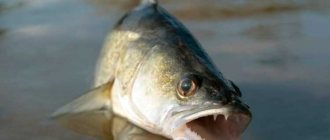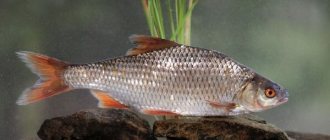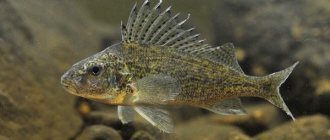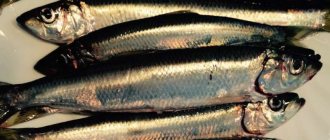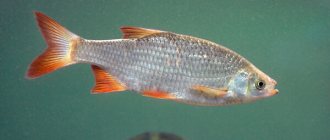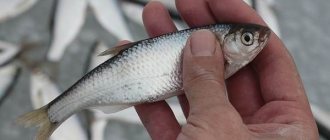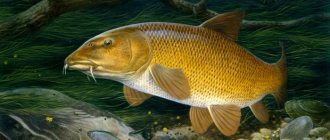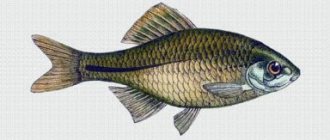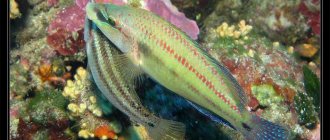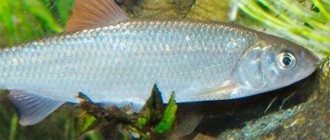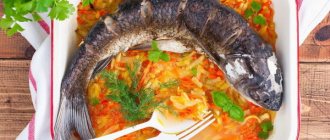Yelets description, photo.
Dace is a small, lively fish, similar in appearance to a young chub.
It is distinguished from the chub by its narrower snout and the color of its fins (in the chub they are much darker). On average, dace grows in length to eighteen to twenty centimeters and weighs one hundred eighty to two hundred grams. Occasionally it can reach thirty centimeters and weigh up to half a kilogram.
The elongated and laterally compressed body of the dace is covered with medium-sized scales. The mouth is small, semi-inferior. The back is dark, shimmering with steel, the sides are much lighter - grayish-bluish, the belly is silvery-white. The dorsal and caudal fin are dark gray. The rest are gray-yellowish, sometimes yellowish with redness. The subcaudal fin is short and has a noticeable notch.
Catching
Dace fishing is possible all year round. In open water, fishing begins in the spring, as soon as the ice melts and the water clears, until the end of October-beginning of November, before freeze-up. There are a variety of methods for catching dace:
- float gear in the wiring
- on a slowly sinking nozzle
- with a slope
- fly fishing with natural and artificial baits
Accordingly, the choice of gear will be different depending on the fishing method.
Fishing with a float rod in the wire
The most common and simplest way is fishing with a float rod in the wire. Gear for catching dace in this way must meet a number of requirements.
The rod chosen is light and elastic, up to 4 m, convenient for constant holding in the hands with frequent recasts. Main line with a diameter of up to 0.22 mm, leader 0.15 mm. The hook is small, No. 3.5-4, the length of the shank depends on the attachment used. The float is selected small, self-loaded or using a small sinker at a distance of at least 10 cm from the hook.
Whatever attachment is used when fishing with a retrieve, the tackle is adjusted so that the hook with the attachment goes at the very bottom
In this case, of course, frequent false hooks are inevitable, and the fishing process itself becomes very complicated. A careful dace is able to instantly and imperceptibly remove the bait from the hook, while the bite is masked by hooking the hook onto uneven bottoms.
You can raise the nozzle a little higher (2-6 cm), but in this case the number of bites may decrease. It would be more correct to adapt to a specific place and study the bottom topography experimentally in order to understand where and how hooks will occur. The reward for patience will be stable bites of dace at the bottom. You should hook when the floating float stops and sinks by about a third. Therefore, the float tackle should be light, balanced and sensitive.
The hook should be fast, but not strong; it is better to do it with one hand, without jerking. Often, fishing with wires takes place by wading, so that it is possible to reach promising places with the tackle. But it should be remembered that dace is a sensitive and timid fish, so the noise and flapping of the gear can scare off a school.
Fishing without a float from the bottom
If the bite weakens or stops when fishing with a wire, you can try catching dace without a float, by pulling the nozzle. The float is removed and the sinker moves lower. The nozzle is thrown freely and sinks to the bottom. Then, after the line is pulled by the current, the tip of the rod slightly pulls the bait lying on the bottom against the current, simulating outgoing prey. The stretch is repeated five to six times. The point is to provoke the dace to bite, when the flock rushes after the departing bait.
Fishing from the surface of the water
In the summer, when insects begin to appear in the dace's diet, you can try fly fishing. For this method of fishing, places with a gentle current, rifts, spits, dams, ponds, wide places on the river where fish can stand, waiting for prey that has fallen into the water, are suitable. The bait is an ordinary fly, a small grasshopper, you can use insects that live near this particular body of water (mayfly, other flying insects).
As a rule, bites follow immediately if a school of dace feeds near the surface. If there is no bite, you can try fishing half-water or from the bottom. To do this, the nozzle needs to be weighted with a jig. The weight of the jig is selected so that the nozzle sinks at a natural speed. This way you can fish all layers, including the bottom one.
Donkey fishing
If the river is sufficiently wide, a donk with a roller can be successfully used. As a rule, when fishing this way, the dace bite is different. The fish holds the bait for a while, pulling on the line until it feels resistance. Therefore, hooking when fishing with a bottom should be immediate after the first signs of a bite.
Fishing for hooked dace does not present any particular difficulties due to the size of the fish. If the hook is carried out correctly, there is little chance of a derailment. It is better to keep dace alive in spacious cages placed further from the shore on the current at the very bottom.
Dace lifestyle.
Dace is a fairly lively and agile fish, very sensitive to water quality. Prefers to stick to the bottom in more or less strong currents. And with the onset of summer, when insects enter the water, the dace moves to the upper layers of the water.
This fish is sociable and lives in fairly large schools.
The sedentary way of life of the Yelets lies in the fact that they adhere to a specific area. In the morning they go out to a nearby rift, and in the evening they return down to the pits.
Floods can disrupt the sedentary life of dace. Since it cannot tolerate turbidity at all, it immediately begins to move upward until it reaches clean water, where it settles for some time.
With the onset of autumn and colder weather, dace goes out into the riffles less and less, and tries more to stay in the depths.
For the winter, the dace goes to deep places and does not show any activity.
dace fishing spots
Dace overwinters in deep holes. In March it begins to move up the river.
Dace spawns very noisily, as it gathers in large flocks. Spawning occurs in early spring at a water temperature of 7°C. To spawn, it enters very shallow rivers, and sometimes even streams with insignificant depth, but with fast flow and clean water. The eggs are small and sticky. Hatching occurs after 10-12 days.
In summer, dace stays in schools below riffles, dams, and near pools in fast currents. Here he finds not only fresh water, but also food.
How and what to catch dace with.
They start catching dace as soon as the water clears. And they catch it almost until late autumn
The best way to fish is by wire. This method requires bait. Various cereals, crackers, and chopped worms are suitable for bait.
Tackle for catching dace.
You can catch dace with a float rod, fly fishing, a fishing rod with a side nod and a jig.
Lures for dace.
For bait, take pieces of worms, insect larvae, cereal grains, flies and grasshoppers.
attachments for dace
The dace feeds on bloodworms, caddisfly larvae, and planktonic crustaceans. In the spring it destroys the eggs of other fish, and in the summer, like the roach, it likes to feed on algae - filamentous. The dace causes significant harm in the spring, when, having spawned early, it stands on the spawning grounds of other fish for about a month and a half and eats their eggs.
During the flight of insects in the evening and at night, it stays near the surface of the water, picking up falling mayflies, stoneflies, and mosquitoes. With the onset of cold weather, the dace goes deeper, but feeds until freeze-up. Overwinters in deep holes with a fairly high oxygen content.
Dace fish how to cook
Bait is needed to catch almost all types of peaceful fish. Only predatory fish do not need bait. Bait is also needed when catching dace.
At the same time, you need to remember that the dace should only be lured, but not fed, like any other fish. Although, when preparing bait for dace, several other proportions should be followed: 30-40% of the total bait is the bait , and the remaining 60-70% is earth or clay .
The dace immediately reacts to bait thrown into the water, and it is of little interest to the composition of this bait. This means that no special ingredients are required for its preparation. But, as you know, many fishing enthusiasts do their own research and create their own recipes, both simple and complex.
The simplest and easiest to prepare bait consists of white bread . Before use, it should be soaked, after which a dough-like porridge from it is applied to stones, which are then thrown into the water. Bread soaked in water creates a food cloud, and its smell attracts flocks of dace.
Some fishermen pass the bread through a meat grinder along with the seeds. Take one pack of seeds per loaf of bread. Upon arrival at a reservoir, such a dry mixture is mixed with soil and water from this reservoir. From the resulting bait you can roll balls with a diameter of up to 50-100 mm and throw them at the fishing point.
Spring dace
Regardless of what gear is their favorite, in early spring many anglers deliberately put them aside and pick up a Bolognese fishing rod. The “king” of such fishing trips is often dace. This small but very lively fish turns into a real outlet for the fisherman. Of course, later the list of trophies will be replenished with large bream and crucian carp, but the first spring dace will be remembered throughout the entire open water season, making you look forward to meeting this fish on a small river.
Where to look for dace in spring?
As with catching any fish in the spring, the success of fishing for dace largely depends on whether the angler has chosen the right place to fish. It is for this reason that experienced “guides” practice two main fishing tactics - fishing at a known proven point or actively searching for fish, during which the angler walks more than one kilometer during the daylight hours, fishing promising places.
- Sand spits, washed up by flood waters, cutting into the main water area of the river and forming a sharp increase in depth to the maximum level. Wiring is carried out along the dump. The working descent can be installed both in the immediate vicinity of the bottom, so that the hook occasionally strikes the ground, and for fishing by dragging, when the sinker is pulled along the bottom at a speed significantly lower than the speed of the current.
- The flooded border of last year's aquatic vegetation, the depth in the immediate vicinity of which is 1–1.5 m. Such places are almost always inhabited not only by dace, but also by other “white” fish. The main fishing tactics at such points are controlled retrieval, carried out by pulling, or even floating of equipment at a speed equal to the speed of the current.
- Pits, “returns” and pools, as well as the runs that crown them. It should be understood that in the format of small rivers, a depth of 2–3 m will be considered a hole. It is in such areas, as well as at the exit from them, that dace bites are frequent. Fishing tactics: uniform fishing along the border of the main stream and the return stream.
- Flowing rivulets and streams, as well as areas adjacent to them in close proximity. The food carried by the current actively attracts fish to the mouth, and therefore you can find here not only dace, but also chub, ide, and large roach.
- Flooded coastal willow is also a favorite habitat for dace in spring. Wiring here is accompanied by frequent snags: the water level is still quite high, and therefore many branches and individual bushes are hidden from the eyes of the fisherman. However, as practice shows, this is where the largest dace are found.
Despite the fact that these areas are the priority for fishing, you can also meet dace on a straight, unremarkable run. Therefore, you should fish at all points without exception, paying close attention to the circles diverging on the surface - a sure sign of feeding fish.
Fishing tactics depend entirely on the behavior of the fish and its activity. Very often, dace may prefer one fishing style. Indicative cases are when the dace exclusively grabbed a worm dragging along the bottom, ignoring the same one floating above the bottom when fishing under pressure, or preferred a bait that was uniformly floating at the speed of the current, avoiding any intervention by the angler in the retrieve. Very often, a half-bottom also helps out: the float rises to the tip of the rod, the weight of the sinker increases by 3–5 g, and the equipment is cast downstream. Fishing in such a situation is carried out from the bottom; the bite indicator is a float lying on the surface of the water or hanging in the air.
Gear used for fishing
Small rivers almost always have relatively shallow depths, thick willow along the banks, a large number of thickets, snags and beaver lodges hidden from the eyes of the fisherman. Such features leave their mark on the gear used. Moving in the described conditions with a long “lapdog” is very problematic, and therefore the fisherman is forced to choose a compact (4–5 m) rod equipped with a lightweight spinning reel. Moreover, in particularly difficult conditions you have to fold your knees and fish with a long rod. The installation is also different: shallow depths and moderate currents do not require heavy equipment, and therefore a float loaded with one “olive” is quite sufficient. The installation is completed with a small swivel and a leash 30–40 cm long with a hook No. 12–14 tied to it. The size varies depending on the type of attachment used.
Dace in spring
Dace in the spring, in this article I’ll tell you where they catch it and what gear they use for dace in the spring. What bait should you choose? What do you use to catch dace closer to summer?
The large dace resembles a young chub. This is purely external resemblance. Of course, the chub is much brighter with its scarlet fins, has a denser or, as they also say, slab-like body, and is incomparably larger in size than the dace. But there is something in the dace from the chub. This is the swiftness and elegance of the entire figure of this beautiful fish, which does not have such red feathers-fins, but is also very silvery and beautiful. The dace also has similarities with the bleak in its coloring, where the silver of the sides turns into the blue of the back, and in the way of life closer to summer and in the summer, these fish also become similar.
Where and what to catch dace in spring
dace is most often caught together with other fish, such as ide, bream, roach, going to spawning grounds. And here the characteristic fishing spots will be rather the edges of sandy rifts and pits, as well as holes immediately behind the rifts . It is in the spring that catching dace with hooks, feeder gear and other donkeys sometimes becomes more the rule than the exception. And at this time the largest specimens, up to thirty centimeters long, are often encountered. And this is already a quite weighty and worthy fish, resisting on the hook, like a really real chub.
In late spring, catching dace will be more successful in holes under steep banks , where the water usually circles in the opposite direction. Here, float fishing rods are most often used, such as fly fishing rods and Bolognese fishing rods .
Dace in the spring on a fly rod
If we talk about a fly rod (read in detail here) that has a blind rig, then its use is more effective when fishing in a pool , where long casting and retrieving over a long distance are not required. If a catchable place is found, for example, next to a tree lying in the water, where the dace stay in one place, then here these fast and greedy fish will peck without interruption. Usually bites follow on one of the turns of the reverse current, most often where there is a tree in the water or there is driftwood at the bottom.
It is clear that such fishing for dace with a fly rod, where the bait is literally thrown under your feet, requires silence and caution . The dace reacts very sensitively to knocking and steps along the shore, and also clearly sees the fisherman in bright clothes, notices his movements (about the vision of fish). Therefore, when fishing for dace, as well as for chub fishing, camouflage clothing similar to the surrounding landscape is required, and it is also desirable that there be some kind of shelter on the shore in the form of a willow bush or tree. Otherwise, only foolish dace the size of a palm or less will be hooked, or you may not expect a bite at all. If you follow the simple rules of camouflage and silence, you can take such a large dace that the fisherman could not even guess about the existence of such specimens in this place. Moreover, their capture can be a common occurrence in small forest rivers.
Catching dace with a Bolognese rig
Sometimes, for successful spring dace fishing, a fishing rod with a Bolognese rig is necessary. This is a sliding rig, where a spinning reel allows you to release the float and hook with bait over a fairly long distance. It is at long distances that the largest dace are sometimes encountered. Most often, bites occur during the execution of a technique, which in Bolognese fishing is called “holding.” The hook with bait rises from the bottom while holding, and then falls back down again. Most bites happen during the pause.
Bait for spring
For spring dace, the most common and popular bait is worms . At a later time, with the arrival of stable warmth, dace begin to feed on maggots.
Fishing closer to summer
Closer to summer, various insects begin to fall on the water, and later the mayfly flies out. And here, as already mentioned, the lifestyle and method of feeding dace begins to resemble the fatting of bleaks on the surface of the water.
During this period, bottom and float gear may give way to fishing with surface baits . The simplest of them can be called fly fishing with a fishing rod without a float and sinker. Usually a fly, horsefly, mayfly or other insect is thrown over a cliff or floated down a stream into a river. Fly fishing with a fly, as well as ultralight spinning with a microjig, can be called more sporty and exciting. Large dace are even taken on small wobblers that were designed for chub (read here about wobblers for chub). By the way, the capture of large dace is not uncommon among a series of chubs, which by summer also come to the surface and begin to actively feed on insects.
